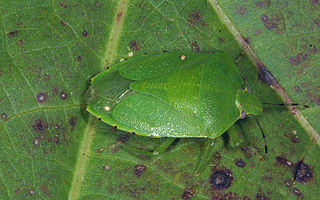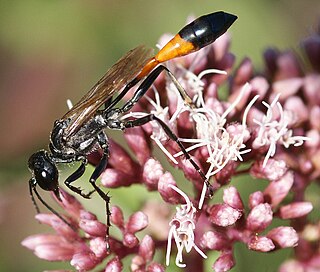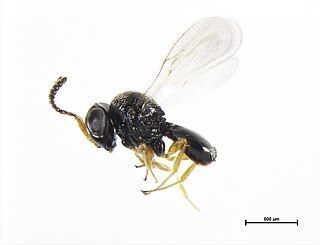
In evolutionary ecology, a parasitoid is an organism that lives in close association with its host at the host's expense, eventually resulting in the death of the host. Parasitoidism is one of six major evolutionary strategies within parasitism, distinguished by the fatal prognosis for the host, which makes the strategy close to predation.

The hymenopteran family Platygastridae is a large group of exclusively parasitoid wasps, mostly very small (1–2 mm), black, and shining, with geniculate (elbowed) antennae that have an eight-segmented flagellum. The wings sometimes lack venation, though they may have slight fringes of setae.

Parasitoid wasps are a large group of hymenopteran superfamilies, with all but the wood wasps (Orussoidea) being in the wasp-waisted Apocrita. As parasitoids, they lay their eggs on or in the bodies of other arthropods, sooner or later causing the death of these hosts. Different species specialise in hosts from different insect orders, most often Lepidoptera, though some select beetles, flies, or bugs; the spider wasps (Pompilidae) exclusively attack spiders.

The green stink bug or green soldier bug is a stink bug of the family Pentatomidae.

The brown marmorated stink bug is an insect in the family Pentatomidae, native to China, Japan, Korea, and other Asian regions. In September 1998, it was collected in Allentown, Pennsylvania, where it is believed to have been accidentally introduced. The nymphs and adults of the brown marmorated stink bug feed on over 100 species of plants, including many agricultural crops, and by 2010–11 had become a season-long pest in orchards in the Eastern United States. In 2010, in the Mid-Atlantic United States, $37 million in apple crops were lost, and some stone fruit growers lost more than 90% of their crops. Since the 2010s, the bug has spread to the nation of Georgia and Turkey and caused extensive damage to hazelnut production. It is now established in many parts of North America, and has recently become established in Europe and South America.

Rhaphigaster nebulosa, common name mottled shieldbug, is a species of stink bug in the family Pentatomidae.

Ammophila sabulosa, the red-banded sand wasp, is a species of the subfamily Ammophilinae of the solitary hunting wasp family Sphecidae, also called digger wasps. Found across Eurasia, the parasitoid wasp is notable for the mass provisioning behaviour of the females, hunting caterpillars mainly on sunny days, paralysing them with a sting, and burying them in a burrow with a single egg. The species is also remarkable for the extent to which females parasitise their own species, either stealing prey from nests of other females to provision their own nests, or in brood parasitism, removing the other female's egg and laying one of her own instead.
Agenioideus nigricornis, the redback spider-hunting wasp, is a species of spider wasp from the subfamily Pompilinae, found in Australia. It is a parasitoid of the venomous redback spider.

Trissolcus japonicus, the samurai wasp, is a parasitoid wasp species in the family Scelionidae, native to east Asia but now found in Europe, North America, and Chile. It is chiefly known for parasitizing Halyomorpha halys. It deposits eggs into the eggs of the stink bug, and as the wasp larvae develop, they kill the stink bug eggs. A single adult wasp emerges from each stink bug egg.

Cermatulus nasalis is a species of predatory shield bug in the family Pentatomidae. It is commonly known as the brown soldier bug or glossy shield bug and is native to Australia and New Zealand.
Anaphes nitens is a species of fairyfly, a chalcid wasp in the family Mymaridae. Native to Australia, it is an egg parasitoid of the gum tree snout beetle, a pest of Eucalyptus trees, and has been used in biological pest control of that species.

Telenomus podisi is a species of egg parasitoid wasps described by William Harris Ashmead in 1893 and placed in the family of Platygastridae. It is a parasitoid of the brown stink bug, Euschistus heros and can be raised in labs on the eggs of Cosmopepla lintneriana, Podisus maculiventris, and Euschistus servus. This wasp can be used in integrated pest management to control E. heros. The insecticide Imidacloprid is lethal for these wasps, and other insecticides have been shown to negatively impact rates of egg parasitism.
Josephine Christina Cardale worked as an entomologist for CSIRO from 1967 to 2001. She was a collection manager of Hymenoptera at the Australian National Insect Collection.

Monteithiella humeralis, commonly known as the pittosporum shield bug is a species of herbivorous shield bug native to Australia and introduced in New Zealand. As its common name suggests, it is most commonly observed feeding on Pittosporum plants.

Trissolcus basalis, or the green vegetable bug egg parasitoid, is a parasitoid wasp in the family Platygastridae known primarily for parasitising the horticultural pest Nezara viridula, the green vegetable bug.

Dictyotus caenosus, commonly known as the brown shield bug, is an Australian species of stink bug that has been introduced into New Zealand and New Caledonia.

Cuspicona simplex, commonly known as the green potato bug, is a herbivorous species of stink bug native to Australia and introduced to New Zealand. It feeds on nightshades. It is primarily known as a pest of potatoes, tomatoes, and other crops in the nightshade family.

Netelia producta is a species of ichneumonid wasp in the subfamily Tryphoninae found in Australia.

Plautia affinis is a species of stink bug found mainly in Queensland and New South Wales, Australia. It was first described in 1851 as Pentatoma affinis by William Sweetland Dallas. It is small, bright green and has brown hemelytra.
Enoggera is a genus of wasp in the Pteromalidae family. It is native to Australia and has five known species. It was introduced to South Africa to serve as biological pest-control against the Eucalyptus destroying beetle, Trachymela tincticollis.
















